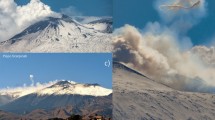Abstract
EVER since Nusselt1 introduced the boundary layer concept, about forty years ago, for calculating rates of heat and mass transfer to a spherical particle, it has been universally accepted (without proof) by subsequent theoretical work (see ref. 2) that the reaction-rate of particles in a dust flame is determined by the rate of supply of oxygen through a diffusional boundary layer surrounding the particles. That this might not in fact be so was first suggested3 about five years ago, the alternative proposition being that the rate control was chemical, not physical ; the source of the implied error is attributed to the mis-interpretation of reaction data in terms of diffusion instead of chemisorption which, according to Brunauer4, has been a common mistake in the past. Support for the alternative hypothesis, however, has now been provided by analysis of experimental results obtained recently from an anthracite flame.
This is a preview of subscription content, access via your institution
Access options
Subscribe to this journal
Receive 51 print issues and online access
$199.00 per year
only $3.90 per issue
Buy this article
- Purchase on Springer Link
- Instant access to full article PDF
Prices may be subject to local taxes which are calculated during checkout
Similar content being viewed by others
References
Nusselt, W., V.D.I., 60, 102 (1916); 68, 124 (1924).
(a) Burke, S. P., and Schumann, T. E. W., Indust. Eng. Chem., 23, 406 (1931); 24, 451 (1932). (b) Hottel, H. C., et al., ibid., 26, 749, 889 (1934); 28, 1334 (1936). (c) Spalding, D. B., Proc. Inst. Mech. Eng., 168, 545 (1954). (d) van der Held, E. F. M., Central Technical Institute T.N.O., Delft, Heat Section Report No. 39.
Essenhigh, R. H., Sheffield Univ. Fuel Soc. J., 6, 15 (1955).
Brunauer, S., “Adsorption of Gases and Vapours”, 10 (Oxford Univ. Press, 1945).
Beér, J. M., Thring, M. W., and Essenhigh, R. H., Combustion and Flame, 3, 557 (1959).
Essenhigh, R. H., and Perry, M. G., Inst. Fuel Conference “Science in the Use of Coal”; Introductory Survey, p. D1 (Sheffield, April, 1958).
Gulbransen, E. A., and Andrew, K. F., Indust. Eng. Chem., 44, 1034, 1039 (1952).
Blyholder, G. D., and Eyring, H., U.S. Air Force Office of Scientific Research Report: Technical Note O. A. No. xx (August 1956).
(a) Essenhigh, R. H., and Thring, M. W., Inst. Fuel Conference “Science in the Use of Coal”, Paper 29, p. D21 (Sheffield, April 1958). (b) Essenhigh, R. H., thesis, University of Sheffield (1959).
Hottel, H. C., and Stewart, I., Indust. Eng. Chem., 32, 719 (1940). Traustel, S., Feuerungstechnik, 29, 105 (1941). Ledinegg, M., “Dampferzeugung”, 238 (Springer-Verlag, Wien, 1952).
Author information
Authors and Affiliations
Rights and permissions
About this article
Cite this article
BEÉR, J., ESSENHIGH, R. Control of Reaction Rate in Dust Flames. Nature 187, 1106–1107 (1960). https://doi.org/10.1038/1871106a0
Issue Date:
DOI: https://doi.org/10.1038/1871106a0
Comments
By submitting a comment you agree to abide by our Terms and Community Guidelines. If you find something abusive or that does not comply with our terms or guidelines please flag it as inappropriate.



